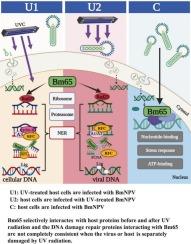Selective interaction of BmNPV Bm65 with host proteins before and after ultraviolet radiation
IF 4
1区 农林科学
Q2 BIOCHEMISTRY & MOLECULAR BIOLOGY
引用次数: 0
Abstract
Baculovirus biopesticides are highly susceptible to inactivation by ultraviolet (UV) radiation in sunlight. At present, the DNA repair mechanism in most baculoviruses after ultraviolet (UV) radiation is still unclear. Our previous research found that Bombyx mori nucleopolyhedrovirus Bm65 was a very important UV-specific endonuclease, and the knockout of Bm65 gene increased the sensitivity of BmNPV to UV radiation. Based on the important role of Bm65 in UV-induced DNA repair, we further explored Bm65-interacting proteins using immunoprecipitation and liquid chromatography-mass spectrometry (LC-MS) assays in this study. The interaction between host DNA repair proteins and Bm65 was detected only after UV radiation. Furthermore, when the viruses or hosts were separately damaged by UV radiation, the DNA repair proteins interacting with Bm65 were not completely consistent. We showed for the first time that BmRad23, a key DNA damage recognition protein of host was a UV-dependent interactor of Bm65, and interacted with Bm65 only after UV radiation. It was further found that Bm65 relied on the interaction with BmRad23 to accurately localize at the sites of UV-damaged viral DNA. These results suggested that Bm65 selectively interacted with host proteins before and after UV radiation, and there might be different pathways that Bm65 participated in the UV-induced DNA repair of viruses or hosts.

紫外线照射前后BmNPV - Bm65与宿主蛋白的选择性相互作用
杆状病毒生物农药极易被阳光中的紫外线(UV)辐射灭活。目前,大多数杆状病毒在紫外线照射后的DNA修复机制尚不清楚。我们前期的研究发现家蚕核多角体病毒Bm65是一个非常重要的紫外线特异性内切酶,敲除Bm65基因增加了家蚕核多角体病毒对紫外线辐射的敏感性。基于Bm65在紫外线诱导的DNA修复中的重要作用,本研究采用免疫沉淀和液相色谱-质谱(LC-MS)分析进一步探索了Bm65相互作用蛋白。宿主DNA修复蛋白与Bm65的相互作用仅在紫外线照射后检测到。此外,当病毒或宿主分别受到紫外线损伤时,与Bm65相互作用的DNA修复蛋白并不完全一致。我们首次发现宿主DNA损伤识别关键蛋白BmRad23是Bm65的一个依赖于紫外线的相互作用蛋白,并且只有在紫外线照射后才能与Bm65相互作用。进一步发现,Bm65依赖于与BmRad23的相互作用来精确定位紫外线损伤的病毒DNA位点。这些结果表明,Bm65在紫外线照射前后与宿主蛋白有选择性相互作用,Bm65参与紫外线诱导的病毒或宿主DNA修复可能有不同的途径。
本文章由计算机程序翻译,如有差异,请以英文原文为准。
求助全文
约1分钟内获得全文
求助全文
来源期刊
CiteScore
7.00
自引率
8.50%
发文量
238
审稿时长
4.2 months
期刊介绍:
Pesticide Biochemistry and Physiology publishes original scientific articles pertaining to the mode of action of plant protection agents such as insecticides, fungicides, herbicides, and similar compounds, including nonlethal pest control agents, biosynthesis of pheromones, hormones, and plant resistance agents. Manuscripts may include a biochemical, physiological, or molecular study for an understanding of comparative toxicology or selective toxicity of both target and nontarget organisms. Particular interest will be given to studies on the molecular biology of pest control, toxicology, and pesticide resistance.
Research Areas Emphasized Include the Biochemistry and Physiology of:
• Comparative toxicity
• Mode of action
• Pathophysiology
• Plant growth regulators
• Resistance
• Other effects of pesticides on both parasites and hosts.

 求助内容:
求助内容: 应助结果提醒方式:
应助结果提醒方式:


